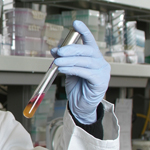Poultry Vaccines May also Improve Human Health
Media Contact:
Jennifer Martin, (202) 720-8188
By Stacy Kish, CSREES Staff
September 2, 2008

Biodesign Institute is leading a USDA-funded project to identify targets to develop a vaccine against an bird infection called Avian Pathogenic E. coli (APEC). The double duty vaccine could also protect people against the most common food-borne illness, Salmonella.
Credit:
Biodesign Institute at Arizona State University
The United States is the world leader in the poultry industry, with annual profits of $50 billion; however, food pathogens threaten the industry. Scientists are especially concerned about Avian Pathogenic Escherichia coli (APEC), which caused an estimated $80 million in losses in 2002.
APEC has the potential to be as harmful as E. coli O157:H7, the strain responsible for human illness and death after consumption of contaminated meat. The genetic similarity between APEC and human E. coli has led scientists to suspect poultry as a source of Extra-intestinal Pathogenic E. coli (ExPEC), which is associated with urethral infections, sepsis, and meningitis.
With funding from USDA's Cooperative State Research, Education, and Extension Service (CSREES) National Research Initiative (NRI), scientists in Arizona are developing a new vaccine for this poultry disease, which, in turn, may improve animal and human health.
Dr. Roy Curtiss and colleagues at Arizona State University began by identifying how E. coli evaded the host's immune system. The researchers used the E. coli bacterial genome to identify the specific genes responsible for triggering its harmful effects. The vaccine produced during this project may lead to additional protection for humans against another pathogen, Salmonella.
"We have to understand how bacteria cause disease so that we can know the best way to fight them," associate research scientist Melha Mellata said. "We came up with a project where we would protect chickens, not only from E. coli infection, but also Salmonella, and in doing so, improve human health."
Antibiotics, the long-time first line of defense to prevent APEC, have lost their potency as the bacteria have grown more resistant to treatment.
"It's becoming increasingly important to develop a vaccine to prevent bacterial infection in poultry," Mellata said. "Poultry is not only a daily food staple, but also a key to human health. For example, the entire supply of annual human flu vaccine production is made from eggs."
Vaccine production for E. coli and Salmonella groups is complicated by the genetic diversity of each bacterium. The new vaccine under development in Curtiss' laboratory is designed to be effective against both E. coli and Salmonella. Curtiss has already developed three vaccines that are effective against multiple strains of Salmonella in livestock. By freeing animals from Salmonella, the vaccine may prevent it from traveling down the food chain to people. The vaccines, which were approved by the FDA for use in swine and poultry, are currently on the market.
CSREES funded this research project through the NRI Food Safety program. Through federal funding and leadership for research, education and extension programs, CSREES focuses on investing in science and solving critical issues impacting people's daily lives and the nation's future. For more information, visit www.csrees.usda.gov.
###
Last Updated: 09/02/2008





